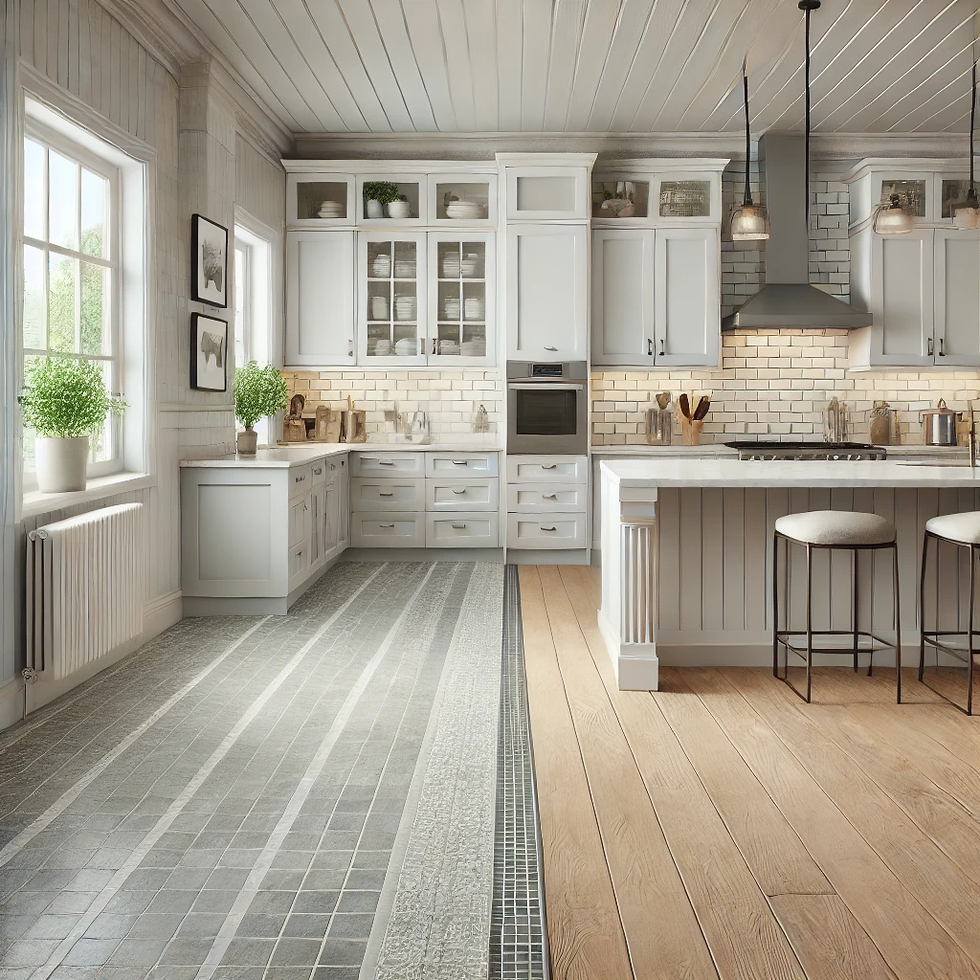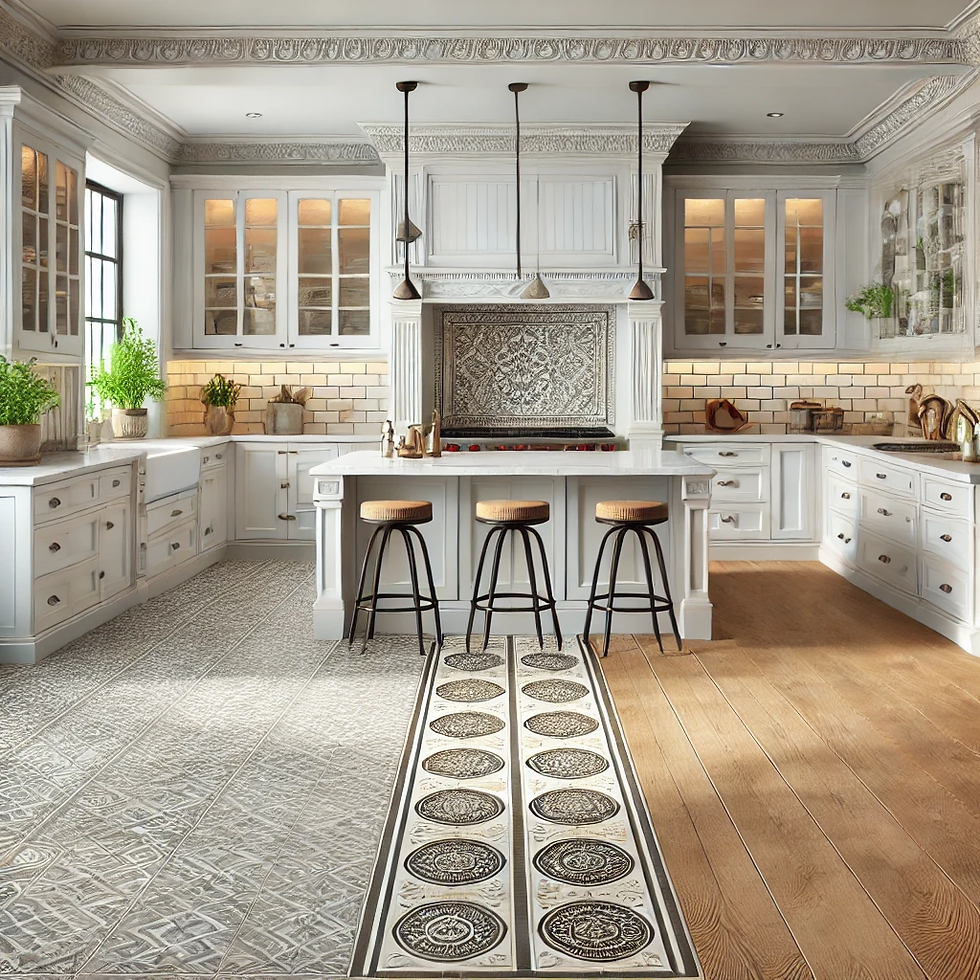Creating a smooth and aesthetically pleasing transition between kitchen tile and wood flooring can significantly enhance the look and functionality of your space. The right transition not only serves a practical purpose but also adds a touch of style to your home. Here are ten creative ideas to help you achieve a seamless tile-to-wood floor transition in your kitchen:
1. T-Molding in Tile-to-Wood Floor Transition
T-molding is a popular choice for transitions between tile and wood floors. This type of molding sits flush with both flooring materials, providing a smooth and unobtrusive connection. T-molding comes in various materials, such as wood, metal, and vinyl, allowing you to match it with your existing decor. Choose a finish that complements both the tile and wood for a cohesive look.
2. Threshold Strips in Tile-to-Wood Floor Transition
Threshold strips, also known as transition strips, are designed to bridge the gap between two different flooring materials. They come in a range of styles and materials, including wood, metal, and rubber. For a seamless transition, select a threshold strip that closely matches the color and texture of your wood flooring. This option is particularly effective for high-traffic areas where durability is essential.
3. Contrasting Border in Tile-to-Wood Floor Transition
Create a striking visual effect by incorporating a contrasting border where the tile meets the wood. Use a different tile color or pattern to form a border around the wood flooring, creating a defined and stylish transition. This approach adds a decorative element to the floor while clearly delineating the two areas.
4. Custom Inlays in Tile-to-Wood Floor Transition
Custom inlays offer a unique and personalized transition between tile and wood floors. This method involves designing intricate patterns or motifs using both tile and wood materials. For instance, you could create a mosaic tile inlay that gradually blends into the wood flooring, adding a touch of artistry and craftsmanship to your kitchen.
5. Gradual Blend in Tile-to-Wood Floor Transition
Achieve a subtle and elegant transition by gradually blending the tile and wood flooring. This technique involves cutting the wood planks into irregular shapes that interlock with the tiles, creating a smooth and organic flow between the two materials. The gradual blend works particularly well in open-plan kitchens, where it maintains a continuous and harmonious look.
6. Metal Transition Strips in Tile-to-Wood Floor Transition
Metal transition strips offer a sleek and modern solution for connecting tile and wood floors. Available in various finishes, such as brushed nickel, stainless steel, and brass, these strips add a contemporary touch to your kitchen. Metal transition strips are durable and easy to clean, making them an excellent choice for busy kitchens.
7. Tile-to-Wood Transition Ramp in Tile-to-Wood Floor Transition
For a practical and seamless transition, consider installing a tile-to-wood transition ramp. This ramp gradually slopes from the tile to the wood flooring, eliminating any potential tripping hazards. Transition ramps are especially useful in areas where there is a significant height difference between the two flooring materials. They can be crafted from wood or metal and customized to match your kitchen's design.
8. Decorative Trim in Tile-to-Wood Floor Transition
Decorative trim, such as baseboards or quarter-round molding, can effectively bridge the gap between tile and wood floors. Choose a trim that complements the style of your kitchen and provides a clean finish to the transition area. Decorative trim can also help protect the edges of both flooring materials, ensuring they remain in good condition over time.
9. Flush Transition in Tile-to-Wood Floor Transition
A flush transition creates a smooth and level connection between tile and wood floors. This method involves installing the two flooring materials at the same height, eliminating any noticeable difference in elevation. A flush transition requires precise installation and careful planning but results in a seamless and polished appearance.
10. Grout Line Continuation in Tile-to-Wood Floor Transition
Extend the grout lines from the tile into the wood flooring to create a unified and cohesive look. This technique involves cutting the wood planks to align with the tile grout lines, maintaining a continuous pattern across both materials. Grout line continuation is an innovative way to blend tile and wood floors while preserving a sense of order and symmetry in your kitchen.
Tips for a Successful Tile-to-Wood Transition
Plan Ahead: Before starting your flooring project, carefully plan the transition area. Consider the layout, design, and functionality of the space to ensure a seamless and practical connection between tile and wood floors.
Select Quality Materials: Choose high-quality transition materials that are durable and match the aesthetic of your kitchen. Investing in quality materials will ensure a long-lasting and attractive finish.
Professional Installation: If you're not confident in your DIY skills, consider hiring a professional installer. A skilled installer will ensure the transition is done correctly and with precision, avoiding any potential issues down the line.
Maintenance: Regular maintenance of both tile and wood floors is essential to keep the transition area looking its best. Clean and seal the grout lines, and periodically refinish the wood flooring to maintain its appearance and durability.
Conclusion : Tile-to-Wood Floor Transition
A well-executed tile-to-wood floor transition can elevate the design of your kitchen, adding both functionality and style. Whether you prefer a subtle, seamless connection or a bold, decorative statement, there are plenty of creative options to suit your taste. Use these ideas as inspiration to create a beautiful and harmonious transition between tile and wood floors in your kitchen.












